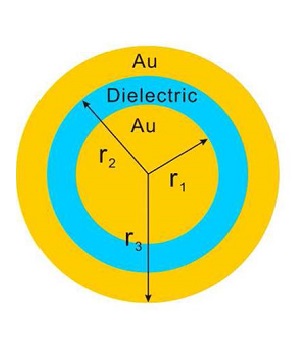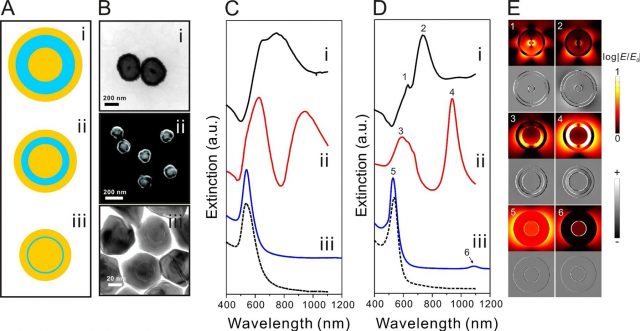Shrinking plasmonic nanomatryoshkas

We know that incident light can provoke a strong optical response in metallic nanostructures due to the excitation of resonant plasmonic modes, i.e, the electrons in the metal become excited by the photons in the incident light and oscillate collectively. One of the most interesting properties of plasmon resonances is their associated enhancement and confinement of non-radiative close-to the-object (or near-field) behaviours, which overcome the diffraction limit of conventional optics and exhibit great potential in numerous areas including energy harvesting, materials science, data communication, and life sciences.
If we place neighbouring nanostructures close enough (plasmonic junctions), there will be a coupling of their oscillations, called the cavity mode, that causes the near-field confinement to be particularly pronounced. On the other hand, it will also be highly sensitive to the presence of any dielectric between the nanostructures. Recall that a dielectric is any nonconductor of electric charge that when placed in an electric field experiments a displacement of its electrons with respect to the nuclei, but not a flow of charge, thus resulting in a dipole which has an electric moment in the direction of the field.

Recently, there has been increasing interest, because of its potential for biosensing and bioimaging applications, in the experimental and theoretical investigations of plasmonic “nanomatryoshka” particles, which consists of a spherical metallic core surrounded by a concentric metallic shell separated by a dielectric layer. The interior “nanogaps”, that is, the core-shell separation, can be easily tuned by controlling the thickness of the dielectric spacer, consequently controlling the extent of the coupling and induced near-field enhancement between the core and shell.
This phenomenon has been well explained by the classical electromagnetic theory, which predicts strong electric field enhancements in the nanogaps region. However, when junction gaps reach subnanometer separation distances, recent studies have shown that quantum mechanical effects, related to tunneling and nonlocal screening, may play an increasingly important role and lead to a reduction in the electric field enhancements. Because classical electromagnetic theory fails to describe plasmonic behavior in such subnanometer gaps, different models have been developed to account for electron tunneling across gaps.

Now, a group of researchers, including Mario Zapata and Javier Aizpurua from the Materials Physics Center CSIC-UPV/EHU and DIPC, presents1 a comprehensive investigation of the optical properties of gold nanomatryoshkas with different nanogap widths ranging from 100 nm down to the subnanometer regime.
They show that classical electromagnetic theory correctly predicts the optical properties of nanomatryoshkas with core-shell separations larger than a nanometer but fails for nanomatryoshkas with subnanometer-sized gaps. This is because it neglects electron transport between the core and the shell through the self-assembled monolayer.
The researchers present a quantum-corrected model that accounts for electron tunneling across the gap by replacing the junction with an effective medium characterized by the tunneling conductance. This model describes both the far- and near-field optical properties in the subnanometer regime.
As the core-shell gap is decreased, the coupling between core and shell plasmons increases and results in increasingly strong hybridization. For subnanometer size gaps, quantum effects such as electron transporting via molecular junctions between the core and the shell become important, resulting in the charge transfer screening of one of the hybridized modes at the gap.
Currently, the advances in the field of quantum plasmonics are limited by the development of suitable techniques for fabrication of subnanometer nanocavities. The researchers also present a scalable bottom-up approach for the fabrication of nanoparticles exhibiting strong quantum plasmonic effects that may pave the way for the development of novel devices based on quantum effects.
Author: César Tomé López is a science writer and the editor of Mapping Ignorance.
References
- Li Lin, Mario Zapata, Min Xiong, Zhonghui Liu, Shanshan Wang, Hong Xu, Andrei G. Borisov, Hongchen Gu, Peter Nordlander, Javier Aizpurua, and Jian Ye (2015) Nanooptics of Plasmonic Nanomatryoshkas: Shrinking the Size of a Core−Shell Junction to Subnanometer Nano Letters DOI: 10.1021/acs.nanolett.5b02931 ↩